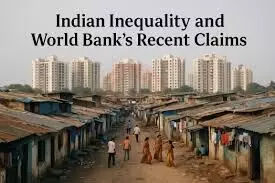India’s Inequality Paradox: Understanding the World Bank’s Consumption Findings

The World Bank’s latest data on consumption inequality in India has sparked both celebration and controversy. According to the World Bank, India’s Gini Index stands at 25.5, making it the fourth most equal country in the world, after the Slovak Republic, Slovenia and Belarus. This finding places India ahead of economic powerhouses like China and the United States, suggesting remarkable progress in reducing inequality. However, this narrative deserves deeper examination, as the story of inequality in India is far more complex than a single metric can capture.
*The Consumption vs. Income Debate*
The key to understanding this apparent paradox lies in distinguishing between consumption and income inequality. The World Bank’s Gini coefficient of 25.5 specifically measures consumption inequality—how evenly consumption expenditure is distributed across the population. India’s consumption-based Gini index improved from 28.8 in 2011-12 to 25.5 in 2022-23. This represents a significant improvement over the past decade, suggesting that the benefits of economic growth have been more widely shared in terms of actual consumption patterns.
However, critics point to a crucial distinction. India’s Gini index for income inequality, comparable with other countries, is 61 (in 2019 and 2023), according to the world inequality database. This stark difference between consumption (25.5) and income (61) inequality reveals a fundamental aspect of Indian society: while income distribution remains highly unequal, consumption patterns are more evenly distributed due to various factors including government subsidies, informal support systems, and different spending behaviors across income groups.
*Policy Interventions and Their Impact*
The improvement in consumption inequality can be attributed to several targeted policy interventions over the past decade. India’s extensive public distribution system, direct benefit transfers, and welfare schemes have helped ensure that basic consumption needs are met across income groups. Programs like the Pradhan Mantri Jan Dhan Yojana have expanded financial inclusion, while schemes such as free food grain distribution during the COVID-19 pandemic directly impacted consumption patterns.
As per World Bank’s Spring 2025 Poverty and Equity Brief, India has lifted 171 million out of extreme poverty. This achievement, measured against the revised poverty line of $3 per day, demonstrates the effectiveness of policies aimed at ensuring minimum consumption standards. The success in poverty reduction has naturally contributed to lower consumption inequality, even as income disparities persist.
*The Limitations of Consumption-Based Measures*
While the improvement in consumption inequality is noteworthy, relying solely on this metric to assess social equity presents several limitations. Consumption-based measures may not fully capture wealth accumulation, asset ownership, or access to quality services like healthcare and education. A household may maintain basic consumption levels while lacking access to quality education or healthcare, which affects long-term mobility and wellbeing.
Furthermore, consumption patterns can be influenced by cultural factors, regional differences, and lifecycle effects that don’t necessarily reflect genuine equality of opportunity. Rural households might have lower cash consumption but higher self-produced consumption, while urban households face higher costs for the same quality of life. These nuances can mask underlying structural inequalities that income-based measures might better capture.
*The Global Context*
With a Gini score of 25.5, India falls into the “moderately low” inequality bracket (25–30) and is on the threshold of joining the “low inequality” group. This achievement is particularly significant given India’s size, diversity, and developmental challenges. Comparing favorably with developed nations in consumption equality while maintaining rapid economic growth represents a unique development model.
However, this success must be viewed in the context of India’s developmental stage. Many countries with low consumption inequality achieved this status after reaching higher levels of per capita income. India’s challenge lies in maintaining this relatively equal consumption distribution while continuing to grow economically and addressing income disparities.
*Regional and Sectoral Variations*
National averages often mask significant regional and sectoral variations. India’s federal structure means that inequality patterns vary considerably across states, with some regions showing much higher disparities than others. Urban-rural divides, caste and community differences, and sectoral employment patterns all influence both consumption and income inequality in complex ways.
The agricultural sector, which employs nearly half of India’s workforce, has different inequality dynamics compared to the services or manufacturing sectors. Understanding these variations is crucial for targeted policy interventions and for assessing the sustainability of current consumption equality trends.
*Looking Forward: Challenges and Opportunities*
The World Bank’s findings present both an achievement to celebrate and challenges to address. Maintaining low consumption inequality while promoting economic growth and reducing income disparities requires sophisticated policy coordination. The key lies in ensuring that as India continues its economic transformation, the benefits of growth translate into both improved consumption opportunities and reduced income disparities.
Future policies must address several priorities simultaneously: enhancing productivity and wages in agriculture, improving quality of education and healthcare access, promoting inclusive growth in manufacturing and services, and maintaining effective social safety nets. The goal should be to achieve what economists call “growth with equity”—where economic expansion reduces both consumption and income inequality.
The World Bank’s report on India’s consumption inequality offers valuable insights into the country’s social progress, but it tells only part of the story. While the achievement of relatively low consumption inequality deserves recognition, it should not overshadow the persistent challenges of income inequality and wealth concentration.
India’s experience demonstrates that targeted government interventions can effectively reduce consumption disparities even in a rapidly growing economy. However, sustainable development requires addressing both consumption and income inequality simultaneously. As India continues its development journey, the challenge lies in maintaining consumption equality while creating more opportunities for income mobility and wealth creation across all segments of society.
The debate around these findings highlights the importance of using multiple metrics to assess social progress. Neither consumption nor income inequality alone tells the complete story—both are necessary to understand the complex reality of India’s development trajectory and the path forward toward a more equitable society.
